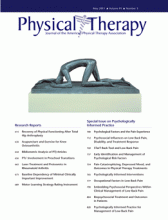Abstract
Background The STarT Back Screening Tool (SBT) was recently developed for primary care providers to use as a screening tool for subgrouping people with low back pain (LBP) on the basis of modifiable prognostic factors. The use of the SBT in physical therapy has not been described.
Objective The aims of this study were to describe the use of the SBT in people receiving physical therapy for LBP and to describe patterns of change in clinical outcomes across the episode of care and among SBT categories.
Design This study was a prospective case series.
Methods A total of 214 patients receiving physical therapy for LBP were administered the SBT at the initial evaluation. Treatment was at the physical therapist's discretion. Clinical outcomes included pain intensity and disability scores collected at each session. Descriptive statistics were calculated, and baseline characteristics among SBT categories were compared. Hierarchical linear mixed models were used to examine patterns of change in predicted outcomes across the episode of care.
Results The patients' mean age was 44.3 years (SD=15.8), and 56.5% were women. The SBT categorized 33.2% of the patients as being at low risk, 47.7% as being at medium risk, and 19.2% as being at high risk. The high-risk category corresponded to the highest initial pain intensity and disability scores. The low-risk category corresponded to the lowest initial pain intensity and disability scores. Linear mixed models indicated different patterns of change in outcome scores for pain intensity (F=3.99) and disability (F=3.49) among SBT categories. Relative to the low-risk category, the high-risk category had larger improvements in predicted outcomes and the medium-risk category had similar improvements in predicted outcomes.
Limitations The SBT was not administered to 24% of eligible patients. The timing of follow-up assessments was variable.
Conclusions The SBT may provide important prognostic information for physical therapists.
Footnotes
Dr Fritz and Dr George provided concept/idea/research design. Dr Fritz provided writing, data collection, project management, participants, and facilities/equipment. All authors provided data analysis. Dr Beneciuk and Dr George provided consultation (including review of manuscript before submission).
This study was approved by the Institutional Review Board of Intermountain Healthcare.
Aspects of the results reported in this article have been accepted for a poster presentation at the 11th International Forum on Low-Back Pain Research in Primary Care; March 15–19, 2011; Melbourne, Victoria, Australia.
- Received March 26, 2010.
- Accepted February 7, 2011.












